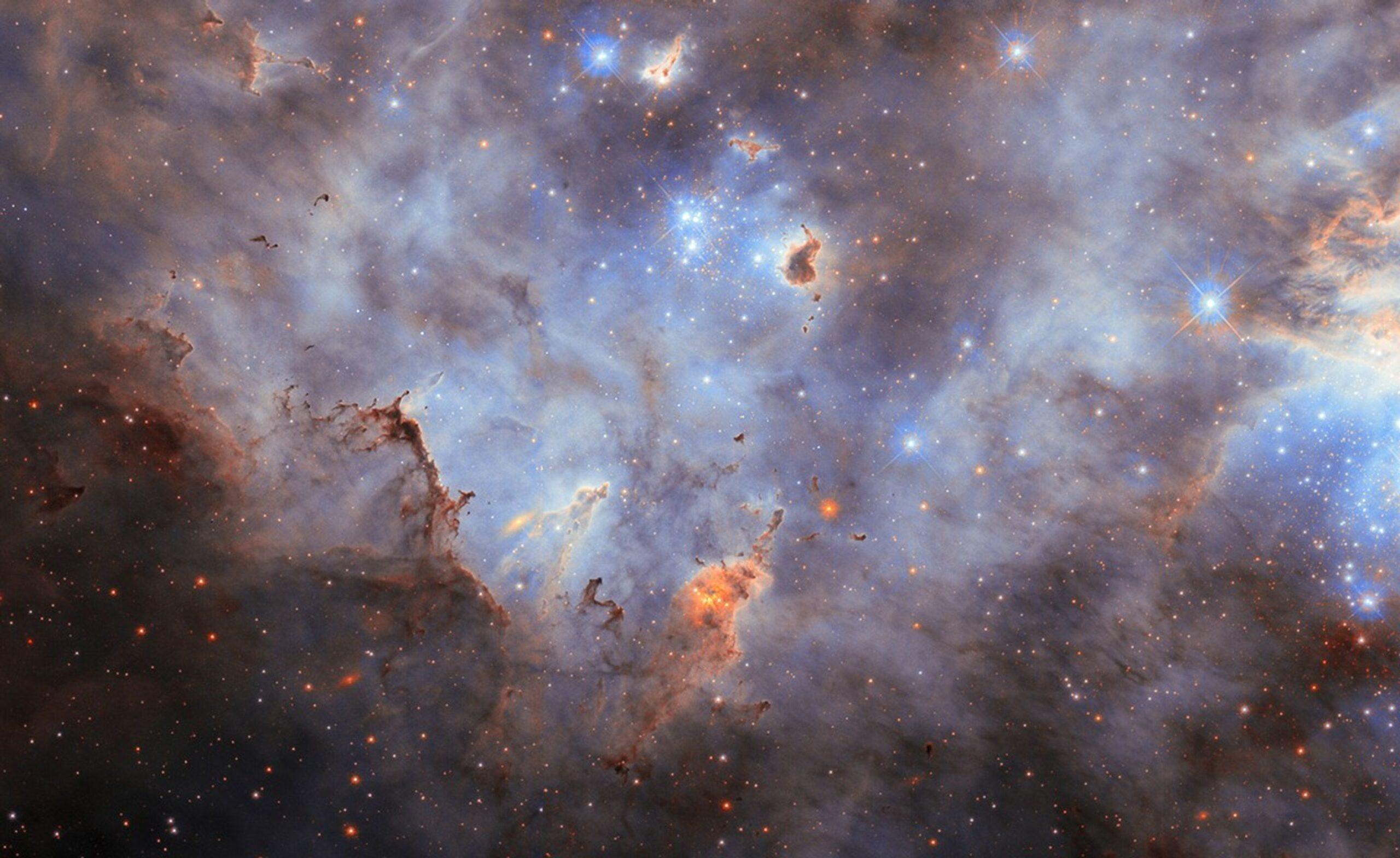
The nebula LMC N44C in the Large Magellanic Cloud, as shown by the Hubble Space Telescope. Credit: ESA/Hubble & NASA, C. Murray, J. Maíz Apellániz
Using BEAST Analytical Tool Running on Bridges-2, Multinational Team Analyzes Millions of Distant Stars at Once
We will grasp much better how our planet, our star, and our Milky Way galaxy came to be once we understand other galaxies and how they developed. The Magellanic Clouds, small galaxies relatively close to us, offer scientists the ability to study them and their individual stars in detail. But analyses of distant stars are slow and computationally expensive. Using a new analytical tool called BEAST, running on the Pittsburgh Supercomputing Center’s Bridges-2 supercomputer, an international team led from the Space Telescope Science Institute studied light spectra from 1.5 million distinct stars in those galaxies, all at once. Their first report agrees well with earlier, smaller scale studies. It also offers the possibility of recognizing in fine detail how these galaxies evolved — and how they’re similar to and different from the Milky Way.
WHY IT’S IMPORTANT
An inconceivably vast Universe surrounds us, stretching beyond our ability to see, much less measure it. Still, scientists have been able to piece together much of how it developed over billions of years.
The precision of our measurements and our explanations, no surprise, tends to get better the closer our observations get to Earth. But many of our questions about how our own Galaxy evolved, how our Sun and planet evolved, and how we came to be, are limited by the fact that we still only have one galaxy, one star, and one planetary system that we’ve measured in detail. Understanding how other galaxies evolved would help us see what’s unique about our neighborhood, and what developed in the same way as everyplace else.
The large and small Magellanic Clouds are two young dwarf galaxies — the closest to our Milky Way. In fact, they’re near enough for our most powerful telescopes, such as the Hubble Space Telescope, to resolve data from single stars among their hundreds of millions. These data can tell us about an individual star’s composition of elements, its age and history, and the amount and composition of dust in between us and it. If we could characterize these individual stars, we could match their populations in each galaxy to what we see in the Milky Way and build an understanding of how these galaxies developed and evolved.
“When we observe a star, we measure a spectrum, or in our case we just take images at different wavelengths to try to approximate the spectrum. We are not only seeing the intrinsic properties of the star, like whether it’s a very hot, massive blue star, or a low mass, red, cool star. We’re also seeing the effects of dust along the line of sight … Our goal is actually to measure those effects … The problem is that this kind of characterization of individual stars, via the spectrum of light that comes from each, is time consuming. The method forces scientists to measure each star separately, which isn’t going to make much of a dent in characterizing a galaxy with hundreds of millions of stars.”
— Claire Murray, Space Telescope Science Institute
Claire Murray, an assistant astronomer at the Space Telescope Science Institute and Johns Hopkins University, wanted to see if she could use a new computational tool, the Bayesian Extinction and Stellar Tool (BEAST) developed by Karl Gordon and his team at the institute, to study stars in the Magellanic Clouds wholesale. Using BEAST, running on PSC’s flagship Bridges-2 supercomputer, she and grad student Christina Lindberg set out to gain spectral data for millions of stars in the two galaxies.
HOW PSC HELPED
BEAST can analyze the light spectra of many individual stars at once at a fraction of the computational and time cost of traditional detailed spectral line analysis. Still, using it to study millions of stars takes serious computing power. Cataloging and analyzing measurements of the light spectra of thousands of stars at a time made it necessary for the computer to hold vast data in its memory, so that the calculations didn’t bog down with repeated movement of data between storage and the processors. Even then, analyzing millions of stars would take many repeated calculations.
“We used the extreme memory nodes on Bridges-2, because … the stellar modeling requires a really big grid of stellar templates … There are seven different dimensions, seven different physical properties that we’re solving for. And so we end up with … a grid that itself is at least 2 terabytes, and so to load that into memory on our local machines [isn’t possible] … We also have 1.5 million stars for this particular project and so processing all of those required just a lot of turning through CPU hours … Bridges-2 really enabled us to improve the precision of our measurements, and then also the speed with which we could process.”
— Claire Murray, Space Telescope Science Institute
Bridges-2’s four extreme memory (EM) nodes were critical for the work. Offering 4 terabytes of memory per node — over 120 times as much as the total in a high-end laptop — and a fast interconnect that allows quick turnaround between each analysis, the NSF-funded system brought analysis of millions of stars within reach.
Involving collaborators at the Space Telescope Science Institute, Johns Hopkins, and several other institutions in the U.S. and Europe, their initial study analyzed 1.5 million stars in the two Magellanic Clouds. They then narrowed the data down to 550,000 stars with particularly clean results that allowed more detailed study. The team found that the populations of stars and their characteristics agreed well with earlier, smaller studies of individual stars in the galaxies, giving them confidence that BEAST’s massive analyses are reliable. The scientists reported their results in The Astrophysical Journal in March 2025.
The stars in the Large Magellanic Cloud proved to be surrounded by measurably more dust than in the Small Magellanic Cloud or the Milky Way. The scientists intend to follow up on that surprising result — why would LMC be different? Future work will also include building maps of dust distribution in the galaxies down the level of parsecs (a large distance by human scales but small compared with galaxies), variations in stars’ relative velocities to us and what they tell us about galactic evolution, and getting better measurements of the contribution of carbon monoxide to the dust blocking the light coming to us from distant stars.
